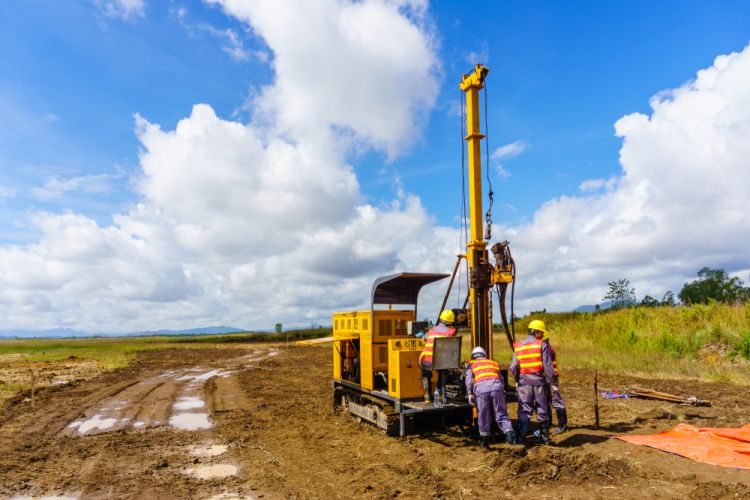Getting The Specialized Geotechnical Engineering Solutions To Work
Getting The Specialized Geotechnical Engineering Solutions To Work
Blog Article
The Buzz on Specialized Geotechnical Engineering Solutions
Table of ContentsSome Known Incorrect Statements About Specialized Geotechnical Engineering Solutions A Biased View of Specialized Geotechnical Engineering SolutionsNot known Details About Specialized Geotechnical Engineering Solutions The Single Strategy To Use For Specialized Geotechnical Engineering SolutionsGetting My Specialized Geotechnical Engineering Solutions To WorkSpecialized Geotechnical Engineering Solutions for Beginners
William Rankine, an engineer and physicist, created an alternative to Coulomb's earth pressure theory. Albert Atterberg created the clay consistency indices that are still made use of today for dirt classification. In 1885, Osborne Reynolds recognized that shearing causes volumetric extension of thick products and tightening of loose granular products. Modern geotechnical design is stated to have begun in 1925 with the magazine of Erdbaumechanik by Karl von Terzaghi, a mechanical designer and geologist. Terzaghi additionally established the structure for theories of bearing ability of foundations, and the concept for prediction of the rate of settlement of clay layers due to loan consolidation. After that, Maurice Biot totally established the three-dimensional dirt loan consolidation theory, prolonging the one-dimensional model formerly created by Terzaghi to much more general theories and introducing the set of fundamental formulas of Poroelasticity.
Geotechnical designers explore and establish the residential properties of subsurface problems and materials. They likewise develop equivalent earthworks and retaining frameworks, passages, and structure structures, and may manage and assess websites, which might additionally involve website surveillance along with the danger evaluation and reduction of natural dangers. Geotechnical designers and engineering rock hounds perform geotechnical investigations to acquire information on the physical properties of soil and rock underlying and surrounding to a website to develop earthworks and structures for recommended frameworks and for the repair work of distress to earthworks and frameworks caused by subsurface conditions.
10 Easy Facts About Specialized Geotechnical Engineering Solutions Explained
Geologic mapping and analysis of geomorphology are generally completed in examination with a geologist or design rock hound. Subsurface expedition generally entails in-situ screening (for instance, the standard infiltration examination and cone penetration test). The digging of examination pits and trenching (specifically for locating faults and slide planes) may also be used to discover dirt problems at deepness. Still, they are occasionally made use of to permit a geologist or engineer to be lowered into the borehole for straight aesthetic and hands-on examination of the soil and rock stratigraphy. Various dirt samplers exist to meet the needs of different engineering tasks. The standard infiltration test, which makes use of a thick-walled split spoon sampler, is the most usual method to collect disrupted examples.

If the interface in between the mass and the base of a slope has a complex geometry, incline stability evaluation is tough and mathematical service methods are required. Typically, the interface's precise geometry is unknown, and a simplified user interface geometry is assumed. Limited slopes need three-dimensional models to be examined, so most slopes are examined presuming that they are definitely large and can be represented by two-dimensional designs.
Top Guidelines Of Specialized Geotechnical Engineering Solutions

Dimension of quantities and assessment of actual problems. It is unsuitable for tasks whose style can not be changed throughout building and construction.
Principles of Geotechnical Engineering. Dirt Mechanics and Structures. Disrupted dirt residential properties and geotechnical design, Schofield, Andrew N., Thomas Telford, 2006.
Specialized Geotechnical Engineering Solutions for Dummies
Principles and Practice of Ground Renovation. Ground Renovation Concepts And Applications In Asia. Style analysis in rock mechanics.
Cengage Knowing, Stamford, 666 p. Atkinson, J., 2007. The mechanics of dirts and structures. The Observational Method in ground design principles and applications.
The smart Trick of Specialized Geotechnical Engineering Solutions That Nobody is Discussing
These records are tailored to satisfy the specific demands of a job and consist of design parameters and suggestions for the building of a series of synthetic structures. As giving consultancy services covering locations such as incline stability and load-bearing capabilities for various materials, these engineers embark on research and advancement activities to enhance methodologies, equipment, materials understanding and analysis covering entire lifecycles.
Engineering the properties and auto mechanics of rocks consisting of the application of characteristics, fluid technicians, kinematics and product auto mechanics. This brings with each other geology, dirt and rock auto mechanics, and architectural design for the layout and building and construction of foundations for an array of civil engineering tasks. This field involves predicting the performance of structure soil and rock to a load imposed by a structure, while taking into consideration efficiency, economic situation and safety.
However, prices of pay usually increase as your understanding and skills grow, with guidelines indicating a graduate beginning wage of between 18,000 and 28,000 per year in the UK. This increases to 26,000 to 36,000 with a few years of experience and after that getting to 40,000 to Full Article 60,000+ for senior, legal or master designers.
Not known Details About Specialized Geotechnical Engineering Solutions
Nevertheless, with the appropriate application it is possible to understand the profession and gain access to a tough yet satisfying and crucial career. A geologist would certainly need to re-train to become a geotechnical engineer, although there is lots of cross-over in between the two occupations, which can make this less complicated. Geologists need to have an understanding of soils, rocks and various other materials from a scientific point of view, while geotechnical designers tale their understanding of issues such as soil and rock mechanic, geophysics and hydrology and apply them to design and ecological jobs.
When starting, these engineers will certainly often tend to deal with much less intricate tasks, developing up expertise and experience ready for more challenging work later. Geotechnical engineers have a tendency to specialise in specific areas as they site link grow in experience, focusing on particular frameworks such as railways, roadways or water. These engineers visit this page also deal with renewable resource, offshore and onshore oil and gas, nuclear power, and much more.
Report this page